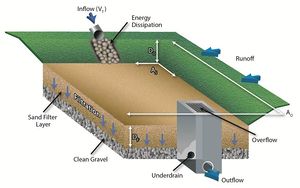
Difference between revisions of "Calculating credits for sand filter"
(Created page with "Creating a page to describe credits for sand filter BMPs is part of an on-going contract. We anticipate having this page in spring, 2015. For now, information on volume and...") |
m |
||
| Line 1: | Line 1: | ||
| − | + | {{alert|This site is under construction. Anticipated completion date is May, 2015.|alert-under-construction}} | |
| − | + | [http://stormwater.pca.state.mn.us/index.php/Overview_of_stormwater_credits Credit] refers to the quantity of stormwater or pollutant reduction achieved either by an individual BMP or cumulatively with multiple BMPs. Stormwater credits are a tool for local stormwater authorities who are interested in | |
| − | *[http://stormwater.pca.state.mn.us/index.php/ | + | *providing incentives to site developers to encourage the [[Credits for Better Site design|preservation of natural areas and the reduction of the volume of stormwater]] runoff being conveyed to a best management practice (BMP); |
| − | *[[ | + | *complying with permit requirements, including antidegradation (see [http://stormwater.pca.state.mn.us/index.php/Construction_stormwater_permit]; [http://stormwater.pca.state.mn.us/index.php/MS4_General_Permit]); |
| + | *meeting the [http://stormwater.pca.state.mn.us/index.php/Performance_goals_for_new_development,_re-development_and_linear_projects MIDS performance goal]; or | ||
| + | *meeting or complying with water quality objectives, including [[Total Maximum Daily Loads (TMDLs)|Total Maximum Daily Load]] (TMDL) Wasteload Allocations (WLAs). | ||
| + | This page provides a discussion of how sand filter practices can achieve stormwater credits. | ||
| + | |||
| + | ==Overview== | ||
| + | [[File:Sand filter credit article.jpg|thumb|300px|alt=schematic showing sand filter system|<font size=3>Schematic illustrating the components and processes for a sand filter system.</font size>]] | ||
| + | |||
| + | Sand Filters are filtration practices that use sand media to filter and remove pollutants from stormwater before entering the downstream stormwater system or BMP. Enhanced Sand Filters, also known as iron enhanced sand filters or Minnesota Filters, use iron mixed with the filter media to improve removal of dissolved constituents from the stormwater. Common types of sand filters are perimeter filters, surface filters, or underground filters. Enhanced sand filters are commonly implemented as filtration basins, or as filtration benches for wet ponds. Because sand filters are not designed to infiltrate or store stormwater, all filters require use of an underdrain to convey treated stormwater out of the system. | ||
Revision as of 12:39, 5 May 2015
This site is under construction. Anticipated completion date is May, 2015.
Credit refers to the quantity of stormwater or pollutant reduction achieved either by an individual BMP or cumulatively with multiple BMPs. Stormwater credits are a tool for local stormwater authorities who are interested in
- providing incentives to site developers to encourage the preservation of natural areas and the reduction of the volume of stormwater runoff being conveyed to a best management practice (BMP);
- complying with permit requirements, including antidegradation (see [1]; [2]);
- meeting the MIDS performance goal; or
- meeting or complying with water quality objectives, including Total Maximum Daily Load (TMDL) Wasteload Allocations (WLAs).
This page provides a discussion of how sand filter practices can achieve stormwater credits.
Overview
Sand Filters are filtration practices that use sand media to filter and remove pollutants from stormwater before entering the downstream stormwater system or BMP. Enhanced Sand Filters, also known as iron enhanced sand filters or Minnesota Filters, use iron mixed with the filter media to improve removal of dissolved constituents from the stormwater. Common types of sand filters are perimeter filters, surface filters, or underground filters. Enhanced sand filters are commonly implemented as filtration basins, or as filtration benches for wet ponds. Because sand filters are not designed to infiltrate or store stormwater, all filters require use of an underdrain to convey treated stormwater out of the system.
